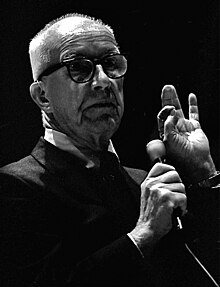Richard Buckminster Fuller
Richard Buckminster Fuller (often abbreviated to R. Buckminster Fuller, also called Bucky Fuller ; born July 12, 1895 in Milton , Massachusetts , † July 1, 1983 in Los Angeles ) was an American architect , constructor , visionary, designer , philosopher and writers .
Live and act
Fuller came from a wealthy family. He was one of four children of the leather goods dealer Richard Buckminster Fuller and his wife Caroline Wolcott Andrews. He was also the great-nephew of Margaret Fuller , an American journalist and civil rights activist. His cousin was the journalist and writer John Phillips Marquand , who received the Pulitzer Prize in 1938 for his novel The Blessed Mister Apley .
In 1914 he met Anne Hewlett (1896–1983), daughter of the prominent New York architect James Monroe Hewlett . The two married in New York on July 12, 1917, his 22nd birthday. They had two daughters, Alexandra (1918–1923) and Allegra (* 1927). Alexandra died of polio and spinal meningitis at the age of four . Allegra Fuller Snyder founded the Board of Directors of the Buckminster Fuller Institute and became its chairman.
He began studying at Harvard in 1912 , but dropped out and became a marine. In 1927, at the age of 32, he was bankrupt and unemployed, and close to committing suicide after the death of his first child. He decided to see the rest of his life as an experiment: he wanted to find out what a single person can do to change the world for the benefit of humanity. He began meticulously documenting his life in a diary, which he then kept for half a century.
After several jobs in industry, including in the export department of a meat processing company, he began to work as an architect . In the late twenties he had some success with new building concepts, which he introduced to the public under the name Dymaxion (Dymaxion globe). Further designs for energy- and / or material-efficient constructions (for example a streamlined car, a bathroom, Tensegrity ) followed, were patented and in some cases also marketed under the Dymaxion trademark. In 1970, Fuller was elected a member ( NA ) of the National Academy of Design .

Fuller was best known for his domes or geodesic domes , also called Fuller domes, which can usually be seen at exhibitions, in science fiction films or as part of military installations ( radomes ), and which he and students at Black Mountain College in 1948 Project study together with Josef Albers . The best known is the Biosphère , the United States' exhibition pavilion at Expo 67 in Montreal . There was also room for roller coasters in these spheres (for example the Eurosat in Europa-Park near Rust). They are based on a further development of the simplest geometrical basic bodies ( tetrahedron as 3-simplex , octahedron and densely packed spheres ) and are extremely stable and can be implemented with the least amount of material. The construction principle was patented in 1954.
Fuller was one of the first to see the work of nature as a continuous systemic work under economic principles (material and energy efficiency and the associated tendency towards ephemerization ). Another important aspect for him was the discovery of useful synergies , a term that he helped to shape.
He worked as a designer, scientist, researcher, developer and writer and propagated global and cosmic perspectives at an early stage, such as in the "Operating Instructions for Spaceship Earth ". He examined the meaning of life in the modern age with the question of the "integral function of man in the universe". His methods and technical constructions, which he developed in later years, attempt to further develop minimal principles in the fields of technology in order to provide means for the sustainable development of our civilization in order to avoid the “cosmic bankruptcy” of mankind . The propagation of the World Game also served this purpose , which - in contrast to conflict simulations - was supposed to show in practice how spontaneous cooperation can improve the lives of all people.
R. Buckminster Fuller died in Los Angeles in 1983, less than 36 hours before his wife Anne. Their grave is in Mount Auburn Cemetery in Cambridge, Massachusetts.
Prizes and awards
In 1968 he became a professor at the Southern Illinois University Carbondale , later also at the University of Pennsylvania . Fuller received 47 honorary doctorates and over 100 awards and prizes between 1954 and 1981 .
The third known elemental modification of carbon was named after him, the fullerenes , whose chemical structure is reminiscent of his domed buildings. The so far best researched fullerene C 60 is also known as Buckminster fullerene or Bucky Ball .
Fuller was a member and later also chairman of the Association for the Gifted Mensa International . He was also accepted into the American Academy of Arts and Letters in 1963 and the American Academy of Arts and Sciences in 1968.
In 2004 the United States Postal Service honored him with a stamp on the 50th anniversary of the patenting of the geodesic domes.
Exhibitions
- 2011: MARTa Herford : Bucky Fuller & Spaceship Earth and We are all astronauts. Richard Buckminster Fuller's universe in the mirror of contemporary art
Trivia
The American artist Matthew Day Jackson honored Fuller with the 2007 wooden portrait Bucky with an eye inlaid with mother-of-pearl. The object was sold to the jeweler Laurence Graff at Christie's in New York in 2010 .
Works (selection)

Concepts and buildings:
- Dymaxion House (1928)
- Dymaxion car (1933)
- Prefabricated compact wet room (1937)
- World Maps (1940)
- Geodetic Buildings (1943)
- Tensegrity Structures (1949)
- Geodesic dome for the Ford Motor Company (1953)
- Patent on geodesic domes (1954)
- World Peace Game , strategy game as an alternative to war games with the aim of general world peace without ecological destruction (1961)
Publications (selection)
- Nine Chains to the Moon. JB Lippincott, New York 1938
-
Education automation. Freeing the Scholar to Return to His Studies. Doubleday, Garden City, 1960
- Education industry. Prospectus of universal planning and instruction. Edition Voltaire, Berlin 1970
-
Operating Manual for Spaceship Earth . Southern Illinois University Press, Carbondale and Edwardsville 1969, online on the Buckminster Fuller Institute website ( December 25, 2011 memento on the Internet Archive ), December 25, 2011 version on the Internet Archive
- Instruction manual for Spaceship Earth and other writings. Rowohlt, Reinbek 1973, ISBN 3-499-25013-6 ; modified new edition: Verlag der Kunst, Amsterdam / Dresden 1998, ISBN 90-5705-015-3
-
The Prospect for Humanity. In: Saturday Review. 1964
- The prospects of humanity. 1965-1985. Edition Voltaire, Frankfurt / Berlin 1968
-
Utopia or oblivion. Jargon Press, Highlands 1969
- Concrete utopia. The human crisis and its chance to survive. Econ-Verlag, Düsseldorf / Vienna 1974, ISBN 3-430-12994-X
- Intuition. Anchor & Doubleday, Garden City 1971
- Synergetics. Explorations in the Geometry of Thinking (with EJ Applewhite). Macmillan, New York 1975/79
-
Tetrascroll. Goldilocks and the Three Bears. A Cosmic Fairy Tale. Universal Limited Art Editions, West Islip 1975
- Goldilocks and the three bears. A fairy tale explains the modern worldview in the space age = Tetrascroll. DuMont, Cologne 1983, ISBN 3-7701-1515-5
- Critical Path. St. Martin's Press, New York 1981
-
Grunch of Giants. Gross Universal Cash Heist. ( March 16, 2010 memento on the Internet Archive ) St. Martin's Press, New York 1983
- Grunch. The giant raid. VAP, Wiesbaden 1985, ISBN 3-922367-15-1
- Cosmography. A Posthumous Scenario for the Future of Humanity (with Kiyoshi Kuromiya). Macmillan, New York 1992, ISBN 0-02-541850-5
- Ideas and Integrities: A Spontaneous Autobiographical Disclosure (Series Editor Jaime Snyder), Lars Müller Publishers, Baden / CH 2010, ISBN 978-3-03778-198-2
literature
- Amy C. Edmondson: A Fuller Explanation. The Synergetic Geometry of R. Buckminster Fuller. ( Memento of October 2, 2003 in the Internet Archive ) Birkhäuser, Boston 1987, ISBN 0-8176-3338-3
- Joachim Krausse & Claude Lichtenstein (Eds.): Your Private Sky. R. Buckminster Fuller. Design as the art of a science. Müller, Baden 2000, ISBN 3-907044-93-2 (exhibition catalog of the Museum für Gestaltung Zürich )
- Joachim Krausse & Claude Lichtenstein (Eds.): Your Private Sky. R. Buckminster Fuller. Discourse. Müller, Baden 2000, ISBN 3-907044-95-9 (supplement to the exhibition catalog)
- K. Michael Hays, Dana A. Miller (Eds.): Buckminster Fuller: Starting with the Universe. Yale University Press (Whitney Museum of American Art) New York 2008, ISBN 0-300-12620-4
- Christof Kehr (Ed.): We are all astronauts. Universum Richard Buckminster Fuller in the mirror of contemporary art , Bielefeld 2011 ISBN 978-3-86678-576-2
- Elena Ochoa Foster (Ed.): Dymaxion Car : Buckminster Fuller, Ivory Press 2011 ISBN 978-0-9564339-3-0
- Kolja Reichert, Everything is getting better and better , FAS No. 5/2018 of February 4, 2018, p. 44
Web links
- Literature by and about Richard Buckminster Fuller in the catalog of the German National Library
- Works by and about Richard Buckminster Fuller in the German Digital Library
- Richard Buckminster Fuller. In: arch INFORM .
- Richard Buckminster Fuller. In: Structurae
- Deutschlandfunk : News from Spaceship Earth - The American Visionary Buckminster Fuller , Feature by Michael Langer, broadcast on December 18, 2009, accessed on May 12, 2010
- Buckminster Fuller Institute website
- Buckminster Fuller on video in the media lounge of the Center for Art and Media Technology ( QuickTime )
- Buckminster Fuller Virtual Institute website
- R. Buckminster Fuller: Thinking Out Loud , website for a TV documentary from the American Masters series
- Buckminster Fuller portrait by Martin Pawley, Telepolis , December 14, 1997
- we are all astronauts. a random design project Nonlinear website of the agency urbn; interaction design based on Buckminster Fuller's theories
- Richard Buckminster Fuller ( Memento from September 28, 2010 in the Internet Archive ) Presentation on the TU Darmstadt website
- The first design researcher ( Memento from April 26, 2011 in the Internet Archive ) Portrait of Marco Siebertz, Roger No. 3
- Manfred Sack : Richard Buckminster Füller The man without a riddle. Apostles of the future tense. In: The time. April 5, 1974. Retrieved July 26, 2011 .
- Danny Kringiel: A life for Dymaxion. Universal genius Buckminster Fuller. In: Spiegel Online - One day. February 21, 2012, accessed November 22, 2012 .
Footnotes
- ↑ The Dymaxion Car by Richard Buckminster Fuller ( Memento from December 3, 2013 in the Internet Archive ), text42.de
- ^ Nationalacademy.org: Past Academicians "F" / Fuller, R. Buckminster NA 1970 ( Memento from January 14, 2014 in the Internet Archive ) (accessed June 22, 2015)
- ↑ United States commemorative postage stamp to honor R. Buckminster Fuller ( Memento from June 29, 2011 in the Internet Archive )
| personal data | |
|---|---|
| SURNAME | Fuller, Richard Buckminster |
| ALTERNATIVE NAMES | Fuller, Bucky |
| BRIEF DESCRIPTION | American scientist, architect, constructor, designer, and writer |
| DATE OF BIRTH | July 12, 1895 |
| PLACE OF BIRTH | Milton, Massachusetts |
| DATE OF DEATH | July 1, 1983 |
| Place of death | los Angeles |



